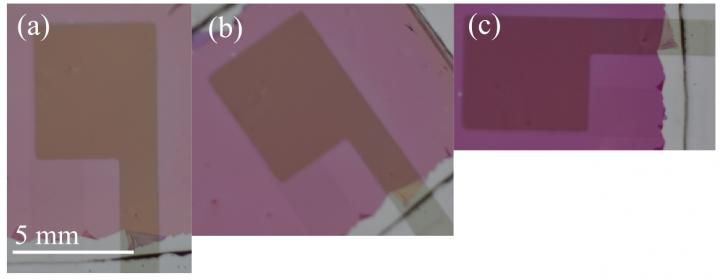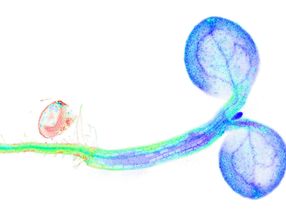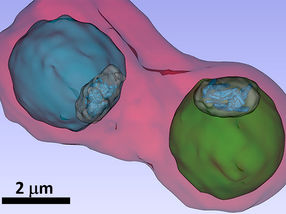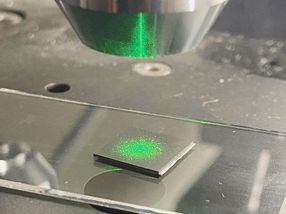Researchers devise new tool to measure polarization of light
Researchers from North Carolina State University have developed a new tool for detecting and measuring the polarization of light based on a single spatial sampling of the light, rather than the multiple samples required by previous technologies. The new device makes use of the unique properties of organic polymers, rather than traditional silicon, for polarization detection and measurement.

This is a close up view of the semitransparent polarization detector. The square area that shows up well is one of the gold electrodes, underneath which is the organic photovoltaic (OPV) material which converts polarized light into an electrical signal. In these images, the background light is linearly polarized. Rotating the detector within this polarized light reduces the transmitted light's brightness as the device is aligned to it. (a) OPV device at 0 degrees; (b) 45 degrees; and (c) 90 degrees. At 90 degrees, the device absorbs the most light, indicating that the background polarization state is oriented parallel to the OPV. This change would be represented as an increase in the detected current.
Michael Kudenov, NC State University
Light consists of an electric field. That electric field oscillates, and the direction in which that field oscillates is the light's polarization. If the field oscillates randomly, it's referred to as unpolarized light. The polarization of light can be affected in predictable ways when light bounces off, or is scattered by, physical objects.
"We want to detect and measure polarization, because it can be used for a wide variety of applications," says Michael Kudenov, an assistant professor of electrical and computer engineering at NC State and lead investigator on this research. "For example, polarization detectors can be used to pick out man-made materials against natural surfaces, which has defense and security applications. They could also be used for atmospheric monitoring, measuring polarization to track the size and distribution of particles in the atmosphere, which is useful for both air quality and atmospheric research applications."
The new device incorporates three polarization detectors made of organic polymer conductors. Each of the detectors is sensitive to a specific orientation of the polarization. As light enters the device, the first detector measures one orientation of the polarization, and the remainder of the light passes through. This is repeated with the subsequent detectors, effectively allowing each detector to take a partial polarization measurement of the same beam of light. The measurements from all three detectors are fed into a model that calculates the overall polarization of the light.
"Most types of polarized light, particularly in natural environments, have a large linear polarization signature," Kudenov says. "And three measurements are sufficient for us to calculate the state of linear polarization in a light sample."
Previous technologies rely on multiple light samples, either taken at different times or at the same time but from different points in space, which can influence the accuracy of results.
The researchers have tested the new device using a laser to provide initial proof-of-concept data. Early tests show that the device can achieve measurement error as low as 1.2 percent.
"It's a good starting point, though not as good as the best polarization detectors currently on the market," Kudenov says. "However, we're optimistic that we'll be able to reduce the measurement error significantly as we improve the device's design. We're really just getting started."
Original publication
Other news from the department science

Get the analytics and lab tech industry in your inbox
By submitting this form you agree that LUMITOS AG will send you the newsletter(s) selected above by email. Your data will not be passed on to third parties. Your data will be stored and processed in accordance with our data protection regulations. LUMITOS may contact you by email for the purpose of advertising or market and opinion surveys. You can revoke your consent at any time without giving reasons to LUMITOS AG, Ernst-Augustin-Str. 2, 12489 Berlin, Germany or by e-mail at revoke@lumitos.com with effect for the future. In addition, each email contains a link to unsubscribe from the corresponding newsletter.














![[Fe]-hydrogenase catalysis visualized using para-hydrogen-enhanced nuclear magnetic resonance spectroscopy](https://img.chemie.de/Portal/News/675fd46b9b54f_sBuG8s4sS.png?tr=w-712,h-534,cm-extract,x-0,y-16:n-xl)










































